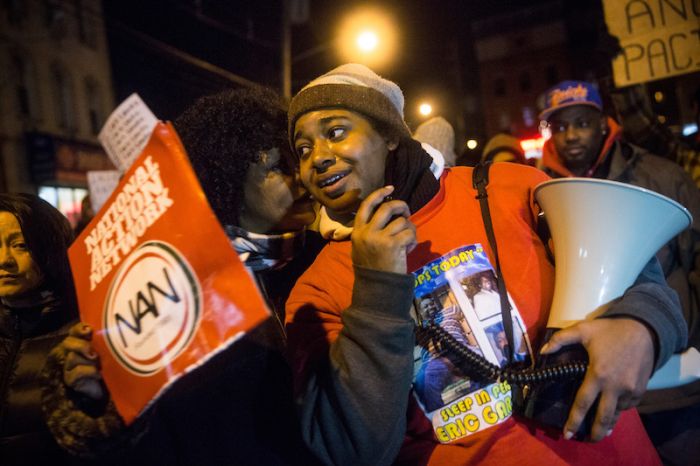This post contains spoilers for the “Black Museum” episode of Black Mirror
Black Mirror, the dystopian anthology about the ills of technology, has for the most part only allowed race to be a storyline in the subtext of its four-season run. Sure we can transpose our own thoughts of race and society’s voyeuristic fascination with black suffering onto episode “White Bear,” or prized white woman rhetoric onto “Fifteen Million Merits,” but in general the series makes black audiences do the work of drawing the lines between its world-building and racial constructions. The series finale, “Black Museum,” however, is all about race. Especially in its third act.
The episode follows Nish (masterfully played by Letitia Wright), a black woman who finds herself in a museum of artifacts from past technological crimes. The final act reveals that her father had been wrongly convicted of murdering a prominent white female journalist and was sentenced to death. The museum owner convinced the father to allow his consciousness to be placed into a 3-D computer image where museum goers could reenact his execution at their own hands and keep souvenirs of his suffering. In the end, we find out that Nish’s plan was to enact revenge on the museum owner for his treatment of her father and the emotional trauma of it all that caused her mother’s death as well.
It’s all there. Right there in that final act. We see how black people, often those lost in the system, are the guinea pigs for dangerous and dehumanizing experiments. We see that even in a futuristic world of technological advances there still isn’t enough evidence to convince society that we’re innocent. We see the delight white people find in black death. And we see the emotional trauma racist violence has on generations of black people, namely women.
Which brings me to Erica Garner.
I watched “Black Museum” hours after hearing about Erica Garner’s passing. In many ways, Nish was a cinematic representation of Garner. They’d both watched their fathers executed by a supposed justice system designed only to harm black folks. Their families were essentially destroyed by an unrelenting need to murder innocent black people. Erica Garner became an activist after the NYPD killed her father. She’s had to watch her own father’s murder and the subsequent miscarriage of justice that has allowed the officers to live their lives without any recourse. Overnight she was fighting for black lives at the risk of her safety and emotional well-being. It should also be mentioned that Garner died from a heart attack at age of 27, just months after giving birth, which makes her part of an alarming community of black women dying within a year of having children. Another sign that black women are left behind in the world’s technological advances.
The emotional crescendo of “Black Museum” comes when Nish is face-to-face with her father, in a vegetative state from years of abuse. It’s a reminder that black women not only experience state-sanctioned violence but they also bare the emotional responsibility of coping with it. When I see Nish’s face, I think of Myrlie Evers finding her husband, Medgar, dead outside of their house. I think of Emmitt Till’s mother choosing to have an open casket for her son. I think about Betty Shabazz shielding her children while gunfire rained down on her husband, Malcolm X, then giving him CPR to try to revive him. This is in addition to the violence black women themselves have to endure.
Erica Garner carried the murder of her father on her heart for years and Nish literally carried her dead mother’s consciousness in her brain. I watched “Black Museum” and wished that Erica Garner could have gotten justice or the same sense of closure that Nish was able to execute. I felt pride and happiness at Nish’s fate but sadness that Erica Garner was robbed of her chance at happiness. The episode is as emotionally relevant as any in the series’ history.
When Erica Garner died, her representatives asked that only black journalists call for interviews. It was a reminder of the need for black people to tell our stories. In the days after I watched “Black Museum,” I searched the internet for reviews and they none mentioned the racial themes of the episode. All written by white people. Meanwhile on social media, black people who saw the episode are heaping praise on it for its emotional gravity and understanding of racial injustice. Of course, the people writing the reviews generally can’t be bothered to ask black people for our takes.
Erica Garner saw how the narratives of her own family were dictated by white journalists and the need for black voices to represent these stories as truthfully as possible. That’s the lasting legacy of a creative endeavor like “Black Museum” and our responsibility to Erica Garner. The real-life victims of state-sanctioned death don’t get the ending Nish found face to face with her father. Instead, they get silenced, misrepresented and cast aside. Erica Garner won’t be cast aside. We won’t let her. She will stand forever in America’s Black Museum along with other monuments we won’t let be forgotten.










Comments
Bossip Comment Policy
Please read our Comment Policy before commenting.